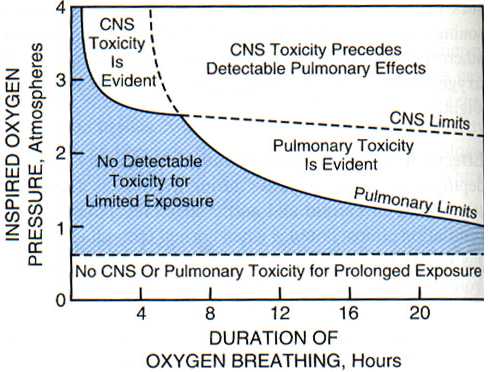What partial pressure of oxygen is toxic?
2 Answers
oxygen is not toxic but it is an oxidant too strong for our body if its partial pressure is over the 30%. So we can not breathe if its % is under the 18%. Our lungs have evolved in the condition in which oxygen is the 21% but perhaps if the conditions were been different, also its limits could be different
Short answer: Oxygen is toxic above a partial pressure of 1.6 bar.
Explanation:
There are two important types of oxygen toxicity:
- Central nervous system (CNS) — convulsions followed by unconsciousness
- Pulmonary (lungs) —difficulty in breathing, coughing. and chest pain
CNS oxygen toxicity
The normal partial pressure of oxygen in the atmosphere is about 0.2 bar.
Resting individuals can tolerate 1.6 bar of oxygen , but only 1.3 bar when exercising.
Symptoms of toxicity can occur after several days at pressures above 0.5 bar.
Pulmonary oxygen toxicity
Pulmonary toxicity occurs after prolonged exposure to partial pressures of oxygen greater than 0.5 bar.
Oxygen at 2.5 bar produces characteristic pulmonary signs and symptoms:
- After 5 h, mild irritation of the trachea
- After 10 h, intense uncontrolled cough
- After 15 h, chest pain and severe difficulty in breathing
- Finally, death

The diagram above shows that oxygen toxicity depends upon both the oxygen pressure and the duration of exposure.
The safe duration of exposure becomes shorter as the partial pressure of oxygen increases.
- Below 0.5 bar, indefinite exposure appears to be safe
- Between 0.5 and 1.6 bar, pulmonary toxicity occurs after prolonged exposures but CNS effects are not detectable
- Above 2.5 bar, CNS toxicity appears before pulmonary effects are detectable.

